| Botanical Name |
|
| Family |
Sapindaceae - The litchi and soap-berry family. |
| Pronunciation |
hip-oh-BRO-mus PAW-see-flor-us |
| Common Name(s) |
Afrikaans: Basterperdepis
IsiXhosa: umnukambiba; isifutha; Ulwathile
IsiZulu: Isiphahluka; Umnungumabele; Umfazothethayo
|
| Plant Group |
- Tree A woody, self-supporting perennial plant usually with a single main stem and generally growing more than 6 meters tall.
|
| Plant Size |
- Small
| Tree | 4m to 8m |
| Shrub | 50cm to 75cm |
| Perennial/ground cover | 10cm to 20cm |
| Bulb | 20cm to 30cm |
| Succulent | 10cm to 20cm |
|
| Position |
- Canopy Shade Canopy shade is found below closely grown trees where some light filters through. Ideal for the protection of herbaceous plants.
- Light or Dappled Shade Found below trees with sparse, open foliage. Ideal for the protection of herbaceous plants.
- Partial Shade The area is in shade for part of the day and in full sun for part of the day.
- Sun The area is in full sun for all or most of the day, all year round.
|
| General Information |
- Attractive fruits, berries or seeds Brightly coloured fruits or berries increase and extend the visual impact of the plant and are especially attractive to birds and other small wildlife.
- Drought Tolerance: High The plant is well adapted to arid conditions; it can survive long periods of drought and high temperatures without extra water.
- Evergreen Plants that have leaves all year round.
- Fragrant / Aromatic These plants posses a strong, usually pleasant odour.
- Frost: Half-hardy The plant is able to survive low temperatures and some frost but requires protection against severe frost.
- Roots Invasive Do not plant near pools, paving, walls or buildings.
- Water Wise Plant species originating from low rainfall regions that require less water to survive and thrive than other plant species.
- Wind Tolerant Plants able to withstand the effect of strong winds.
|
| Specific Information |
Hippobromus pauciflorus is a densely leafy, semi-deciduous shrub or tree with an attractively shape, rounded crown. All parts of the tree have an unpleasant odour when bruised.Very pretty when the unpalatable berries ripen. New growth has a reddish coppery colour. The tree prefers moist but not wet soil. That said, the specimens in my garden have thrived throughout many years of drought and in fact become more than somewhat invasive. A most attractive tree but watch out for seedlings and suckers and take appropriate action timeously.
|
| Ad Break |
|
| Flowers |
| Description |
very small in dense, velvety heads on short stems
|
| Season |
- Autumn to Winter Plants will seldom bloom for the entire season as given in the list, but should flower during a period within these parameters.
|
| Colour |
|
| Growth Rate |
- Fast Specifying growth rate can be very misleading as there is considerable variation of growth rate depending on type and species of plant, available water, supplementary feeding, mulching and general care, as well as the plants suitability and adaptability to the garden environment.
|
| Plant Uses |
- Attracts bees, butterflies or other insects This plant attracts insects which can be food for birds or other creatures in your garden.
- Attracts Birds This plant will attract birds.
- Boundary A plant useful for planting around the edges of the property to form a green or colourful backdrop, an impenetrable hedge, to hide walls or create privacy.
- Filler Either a fast growing tree or shrub used temporarily to fill in an area while the permanent plants grow to a desired size, or a plant used to fill gaps in borders or beds.
- Hedge Suitable trees or shrubs planted relatively close together so that the branches intertwine to create a barrier. This can be formal – the plants are regularly trimmed to produce a neat shape, or informal – the plants are left to themselves to create a natural hedgerow.
- Pioneer for new gardens A very fast growing plant, able to withstand hardship, that can be used to populate land that has recently been cleared of natural vegetation. These plants pave the way for slower-growing species by adding nutrients to the soil and creating leaf litter.
- Provides light / dappled shade A tree with an open to sparse canopy, through which varying degrees of sunlight can penetrate.
- Screen A tall hedge of suitable plants planted closely together and used as a windbreak, to block a bad view, to separate parts of the garden or as a backdrop.
- Suitable for coastal gardens Plants adapted to dry, sandy soil, forceful wind, limited rainfall and intense sunlight.
- Wild Garden An indigenous garden planted for the benefit of wildlife and birds. Provides food, water, a variety of mini-biomes and no poisonous chemicals are used.
- Windbreak Trees planted in a row to form protection from prevailing winds by breaking the force of the wind, thereby reducing wind damage.
|
| Distribution and Habitat |
in the Eastern Cape Province, KwaZulu-Natal, Mpumalanga and Limpopo, as well as Swaziland and north of South Africa, at forest edges, along river and stream banks and in scrub forest
|
| Planting Suggestions |
Plant in in garden soil mixed with a little compost, a handful of bone-meal and slow release organic fertilizer if your soil is impoverished. Mulch well and water regularly until the tree has adapted to its new environment. For faster growth ensure a steady supply of water. Grows very easily from seed. I haven't tried cuttings but they would most likely be successful, considering the plants propensity to sucker.
The old method of digging a deep hole and filling it with soil and compost has resulted in many trees failing to thrive, dying, rotting at the base or worse still, falling over in later years due to poor root development. Refer to the following sites for the best method of planting trees:
Treehelp.com: Planting a tree
International Society of Arboriculture: New Tree Planting
Tree People: Plant the right way
For those of you who have a clay problem try:
Rod's Garden: Planting in clay soil
|
| Medicinal Uses |
A vapour is released when the leaves are crushed and this is inhaled to relieve a headache. The root is used to cure dysentry, diarrhoea and eye infections, it is given to stock suffering from coughs, and is also used as a love charm.
|
| Ad Break |
|


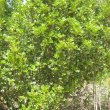
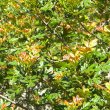


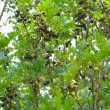
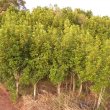
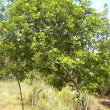


Discuss this plant
Share knowledge, ask a question or give an experience.